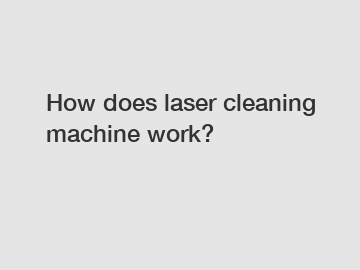Apr. 06, 2024
Have you ever wondered how laser cleaning machines work their magic to remove dirt, rust, paint, and other contaminants from various surfaces? Laser cleaning technology is a cutting-edge method that has revolutionized the way we clean and restore objects without the use of harsh chemicals or abrasives. In this blog post, we will delve into the inner workings of laser cleaning machines and explore the science behind their effectiveness.
Laser cleaning machines operate on the principle of using a high-powered laser beam to heat and vaporize contaminants on the surface of an object. The process is known as laser ablation, where the intense energy of the laser beam interacts with the material on the surface, causing it to evaporate or breakdown into smaller particles. As a result, the contaminants are effectively removed from the surface without damaging the underlying material.
One of the key components of a laser cleaning machine is the laser source, which generates the high-energy beam needed for the cleaning process. Various types of lasers can be used for cleaning applications, including fiber lasers, CO2 lasers, and pulsed lasers. Each type of laser has its own unique characteristics and advantages, depending on the specific cleaning requirements and the type of material being treated.

The laser beam is focused and directed onto the surface of the object using a scanning system, which controls the position and movement of the laser beam. The scanning system ensures that the laser energy is evenly distributed across the surface, allowing for thorough and precise cleaning. Additionally, the scanning system can be adjusted to control the intensity and speed of the cleaning process, depending on the desired results.
As the laser beam interacts with the contaminants on the surface, it heats them up rapidly, causing them to vaporize or sublimate. The high temperatures generated by the laser beam can reach up to several thousand degrees Celsius, depending on the intensity of the laser and the type of material being cleaned. This rapid heating and vaporization process effectively removes the contaminants from the surface, leaving behind a clean and residue-free finish.
One of the key benefits of laser cleaning machines is their ability to clean a wide range of materials, including metals, plastics, ceramics, and composites. Unlike traditional cleaning methods that rely on abrasive blasting or chemical solvents, laser cleaning is a non-contact and non-abrasive process that does not damage the surface of the material. This makes it ideal for delicate or sensitive materials that require gentle cleaning without risking damage or distortion.
In addition to its cleaning capabilities, laser cleaning machines are also highly versatile and can be used in a wide range of applications, from industrial cleaning and restoration to conservation and restoration of cultural heritage objects. The precision and control offered by laser cleaning technology make it an ideal solution for removing stubborn contaminants, restoring surfaces to their original condition, and preserving the integrity of valuable objects.
In conclusion, laser cleaning machines are a powerful and effective tool for removing contaminants from a wide range of surfaces without the use of harsh chemicals or abrasives. The science behind laser cleaning technology is fascinating, as it harnesses the power of high-energy laser beams to vaporize contaminants and restore surfaces to their original condition. With their precision, versatility, and non-contact cleaning capabilities, laser cleaning machines are truly a game-changer in the field of surface cleaning and restoration.
Contact us to discuss your requirements of sheet laser cutting machine supplier, supply tube laser cutting machine pricelist, stainless steel panel bender. Our experienced sales team can help you identify the options that best suit your needs.
If you are interested in sending in a Guest Blogger Submission,welcome to write for us!
All Comments ( 0 )